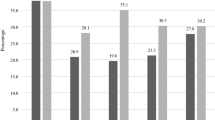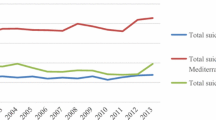Abstract
Purpose
Indian states at greater levels of economic development report more suicides. This relation appears stronger among women relative to men. We test the hypothesis, suggested in the literature, that conflict between rapid economic growth and inadequate female autonomy (approximated using total fertility rate) varies positively with female suicides.
Methods
We used state-level data on female suicides for all 35 Indian states and union territories, from 2001 to 2011, from the National Crime Records Bureau. We specified, as our outcome, age-adjusted female suicides per 100,000 population per state-year. We retrieved data on key covariates, namely, gross state domestic product (GSDP) per capita, total fertility rate (TFR), and other control variables from multiple national surveys and publicly available data sources. We examined whether and to what extent age-adjusted female suicides (per 100,000 population) correspond with total fertility rate (lower TFR indicates greater female autonomy and vice versa) within the context of greater economic development (GSDP per capita). Linear longitudinal mixed effect regressions controlled for state-specific random intercepts, son preference (male:female sex ratio at birth), literacy gap (percentage difference between literate males and females), access to health systems (institutional deliveries), female to male employment ratio, and linear time trends.
Results
At constant levels of GSDP per capita, a one unit decline in TFR corresponds with 0.27 fewer female suicides per 100,000 population (P value = 0.008). Sensitivity tests indicate that this relation does not hold for male age-adjusted suicides (per 100,000 population).
Conclusion
Our findings, if replicated, indicate that at constant levels of economic development, lower TFR (indicating greater female autonomy) may reduce suicide risk among women.



Similar content being viewed by others
Data availability
The state-level datasets are available from the corresponding author. All authors, external and internal, had full access to all of the data (including statistical reports and tables) in the study and can take responsibility for the integrity of the data and the accuracy of the data analysis.
Code availability
The statistical code is available upon request from the corresponding author.
References
Institute for Health Metrics and Evaluation. (2014) GBD compare. http://www.healthdata.org/data-visualization/gbd-compare
Dandona R, Kumar GA, Dhaliwal RS et al (2018) Gender differentials and state variations in suicide deaths in India: the global burden of disease study 1990–2016. Lancet Public Heal 3:e478–e489
Snowdon J (2019) Indian suicide data: what do they mean? Indian J Med Res 150:315
Barredo L, Agyepong I, Liu G, Reddy S (2015) Ensure healthy lives and promote well-being for all at all ages. UN Chron 51:9–10
World Health Organization Comprehensive mental health action plan 2013–2020–2030. http://www.who.int/mental_health/action_plan_2013/en/
Arya V, Page A, River J et al (2018) Trends and socio-economic determinants of suicide in India: 2001–2013. Soc Psychiatry Psychiatr Epidemiol 53:269–278
Moniruzzaman S, Andersson R (2008) Economic development as a determinant of injury mortality—a longitudinal approach. Soc Sci Med 66:1699–1708. https://doi.org/10.1016/j.socscimed.2007.12.020
Moniruzzaman S, Andersson R (2004) Relationship between economic development and suicide mortality: a global cross-sectional analysis in an epidemiological transition perspective. Public Health 118:346–348. https://doi.org/10.1016/j.puhe.2003.10.004
Blasco-Fontecilla H, Perez-Rodriguez MM, Garcia-Nieto R et al (2012) Worldwide impact of economic cycles on suicide trends over 3 decades: differences according to level of development. A mixed effect model study. BMJ Open 2:e000785. https://doi.org/10.1136/bmjopen-2011-000785
Pampel FC (1998) National context, social change, and sex differences in suicide rates. Am Sociol Rev 63:744–758
Anderson S, Genicot G (2015) Suicide and property rights in India. J Dev Econ 114:64–78
Anukriti S, Herrera-Almanza C, Pathak PK, Karra M (2020) Curse of the mummy-ji: the influence of mothers-in-law on women in India†. Am J Agric Econ. https://doi.org/10.1111/ajae.12114
Dyson T, Moore M (1983) On kinship structure, female autonomy, and demographic behavior in India. Popul Dev Rev 9:35–60
Murthi M, Guio A-C, Dreze J (1995) Mortality, fertility, and gender bias in India: A district-level analysis. Popul Dev Rev 21:745–782
Duflo E (2012) Women empowerment and economic development. J Econ Lit 50:1051–1079
International Institute for Population Sciences (2016) India Fact Sheet
Chen Y-Y, Chen M, Lui CSM, Yip PSF (2017) Female labour force participation and suicide rates in the world. Soc Sci Med 195:61–67. https://doi.org/10.1016/j.socscimed.2017.11.014
Vaidyanathan KE (1989) Status of women and family planning: the Indian case. Asia-Pacific Popul J 4:3
Dixon-Mueller R (1993) Population policy and women’s rights: Transforming reproductive choice. ABC-CLIO
Mason KO (1986) The status of women: Conceptual and methodological issues in demographic studies. In: Sociological forum. Springer, pp 284–300
Hindin MJ (2000) Women’s autonomy, women’s status and fertility-related behavior in Zimbabwe. Popul Res Policy Rev 19:255–282
Safilios-Rothschild C (1982) Female power, autonomy, and demographic change in the Third World
Agarwala R, Lynch SM (2006) Refining the measurement of women’s autonomy: an international application of a multi-dimensional construct. Soc Forces 84:2077–2098
Upadhyay UD, Gipson JD, Withers M et al (2014) Women’s empowerment and fertility: a review of the literature. Soc Sci Med 115:111–120
Prata N, Fraser A, Huchko MJ et al (2017) Women’s empowerment and family planning: a review of the literature. J Biosoc Sci 49:713–743
Ly PHAN (2013) Women’s empowerment and fertility changes. Int J Sociol Fam 39:49–75
National Crime Records Bureau Accidental Deaths and amp; suicides in India (ADSI). https://ncrb.gov.in/en/accidental-deaths-suicides-india-adsi
Census of India: area and population. https://censusindia.gov.in/Census_And_you/area_and_population.aspx
Patel V, Ramasundarahettige C, Vijayakumar L et al (2012) Suicide mortality in India: a nationally representative survey. Lancet 379:2343–2351
Dandona R, Bertozzi-Villa A, Kumar GA, Dandona L (2017) Lessons from a decade of suicide surveillance in India: who, why and how? Int J Epidemiol 46:983–993
Arya V, Page A, Armstrong G, et al (2020) Estimating patterns in the under-reporting of suicide deaths in India: comparison of administrative data and Global Burden of Disease Study estimates, 2005–2015. J Epidemiol Community Heal
NITI Aayog (National Institution for Transforming India) Government of, India State Statistics. https://niti.gov.in/niti/state-statistics
Dandona R, Pandey A, Dandona L (2016) A review of national health surveys in India. Bull World Health Organ 94:286
Datanet India Pvt. Ltd. Indiastat. indiastat.com
Abadian S (1996) Women’s autonomy and its impact on fertility. World Dev 24:1793–1809
Alothman D, Fogarty A (2020) Global differences in geography, religion and other societal factors are associated with sex differences in mortality from suicide: An ecological study of 182 countries. J Affect Disord 260:67–72
Organization WH (2018) A vision for primary health care in the 21st century: towards universal health coverage and the sustainable development goals. World Health Organization
Milner A, McClure R, De Leo D (2012) Socio-economic determinants of suicide: an ecological analysis of 35 countries. Soc Psychiatry Psychiatr Epidemiol 47:19–27
StataCorp (2015) Stata statistical software: release 14
Dandona L, Dandona R, Kumar GA et al (2017) Nations within a nation: variations in epidemiological transition across the states of India, 1990–2016 in the Global Burden of Disease Study. Lancet 390:2437–2460
McCracken K, Phillips DR (2016) Demographic and epidemiological transition. Int Encycl Geogr People, Earth, Environ Technol People, Earth, Environ Technol 1–8
Pampel FC (1996) Cohort size and age-specific suicide rates: A contingent relationship. Demography 33:341–355
Van Poppel F, Day LH (1996) A test of Durkheim’s theory of suicide–without committing the" ecological fallacy". Am Sociol Rev 64:500–507
Behere PB, Rao TSS, Mulmule AN (2015) Decriminalization of attempted suicide law: journey of fifteen decades. Indian J Psychiatry 57:122
Ministry of Health and Family Welfare Government of India (2014) National mental health policy of India—new pathways new hope
(2005) The Protection of Women from Domestic Violence Act
Kim D (2018) Marital rape immunity in India: historical anomaly or cultural defence? Crime, Law Soc Chang 69:91–107
Raj A, McDougal L (2014) Sexual violence and rape in India. Lancet 383:865
Durkheim E (1897) Le suicide: étude de sociologie. Alcan
Armstrong G, Vijayakumar L (2018) Suicide in India: a complex public health tragedy in need of a plan. Lancet Public Heal 3:e459–e460
Vijaykumar L (2007) Suicide and its prevention: the urgent need in India. Indian J Psychiatry 49:81
Deininger K, Liu Y (2009) Economic and social impacts of self-help groups in India. The World Bank
Patel V, Saxena S, Lund C et al (2018) The Lancet Commission on global mental health and sustainable development. Lancet 392:1553–1598
Funding
This work was supported by the National Institute of Allergy and Infectious Diseases [Grant Number 1R03AI135322-01].
Author information
Authors and Affiliations
Contributions
PS developed the research concept and managed data collection and analysis. JW assisted with data collection. PS wrote the first draft of the manuscript. PS, TB, and AD edited the manuscript. TB managed, supervised the research project, and provided funding resources.
Corresponding author
Ethics declarations
Conflict of interest
The authors of this paper do not report any conflicts of interest.
Ethical approval
The University of California, Irvine, institutional review board deemed this study exempt owing to the use of publicly available, de-identified data.
Supplementary Information
Below is the link to the electronic supplementary material.
Rights and permissions
About this article
Cite this article
Singh, P., Das, A., William, J. et al. Fertility, economic development, and suicides among women in India. Soc Psychiatry Psychiatr Epidemiol 56, 1751–1759 (2021). https://doi.org/10.1007/s00127-021-02054-4
Received:
Accepted:
Published:
Issue Date:
DOI: https://doi.org/10.1007/s00127-021-02054-4




